Menus
- Exquisite XT
- Gromono for everyone
- Basic and complete
- Who kick ?
- Back to basics
- Chronology
- Second-hand market
- Identification
- Chassis: distrust
- Solid mechanics, but ….
- Maintenance
- Gas station
- Detached pieces
Exquisite XT
After inventing the concept of trail running with the DT 250, the Japanese firm had the audacity to create the 500 XT…. Directly inspired by English machines like the BSA Goldstar, the first big Japanese mono will bring this type of engine up to date.. Derived from the TT 500, an enduro motorcycle, its successes and the many podiums won in the Dakar, will establish its image as a reliable and robust machine. Above all, they will make a whole generation of bikers dream of travel and adventure ….

Gromono for everyone
 When it was released in 1976, it was marketed at 10,193 francs (minimum wage at 1,000 F for 169 hours)…. Simple, versatile, the promise of Yamaha was to offer bikers a machine capable of performing without shadow of the “dodo work bike”, of having fun off-road on weekends and of being able to reach the end of the road. world. Full of character thanks to its consequent torque, the single cylinder provides honorable performance. The light and manoeuvrable cycle part is a major ally that makes driving playful and very engaging. But what will create the aura of the 500 XT is its image of a tireless adventurer "Paris-Dakar ready".
When it was released in 1976, it was marketed at 10,193 francs (minimum wage at 1,000 F for 169 hours)…. Simple, versatile, the promise of Yamaha was to offer bikers a machine capable of performing without shadow of the “dodo work bike”, of having fun off-road on weekends and of being able to reach the end of the road. world. Full of character thanks to its consequent torque, the single cylinder provides honorable performance. The light and manoeuvrable cycle part is a major ally that makes driving playful and very engaging. But what will create the aura of the 500 XT is its image of a tireless adventurer "Paris-Dakar ready".
At this time, the rally raids and the famous eponymous event were born. The victories of Cyril Neveu in the first two editions and the numerous podiums of other drivers will definitely write legend and myth. Simply equipped with a large tank, an additional nurse and the essential luggage rack, these standard machines set off to face the African dunes and nourish the dreams of escapees of the greatest number. The tuning forks brand has succeeded in rehabilitating the single cylinder by making it more reliable. Bikers rediscover its charms and the famous kick start ceremonial. The start-up seems to require science and strength, which gives the 500 an image of a motorcycle that deserves, a motorcycle of purist !

In 1983, Yamaha released the 600 XT which, except name and genre, shared nothing with its predecessor. Disc brake, electric starter, single shock absorber, this bike foreshadows what will be the popular trail of the 80s with the Honda XLs and other Suzuki DRs. Maintained in the catalog until 1989, the 500 will slowly fall into oblivion until the beginning of the 2000s. Those who started riding with it or who experienced their first biker emotions as a child have set their sights on it. research. Its minimalist design enhances the small aluminum tank flanked by the black and red logo, a classic. As with its small round lighthouse and its elongated silencer, we recognize it among all.
Basic and complete
If the XT is derived from the TT 500 as the "enduro" sticker on the sides of the first versions underlined, its suspension travel is surprisingly reduced at the rear for off-road vehicles (only 100 mm). With a fairly open head angle and straight handlebars like justice, the 500 sits proudly on its 21-inch front wheel and seems to bulge out its chest. The silencer that runs along the saddle refines the machine without making it frail. The fuel tank of only 8.5 liters and the tubular single cradle frame reinforce the massive appearance of the engine.
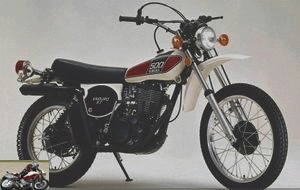
Obsolete elements today, the fork bellows seem to respect a symmetry with the pair of rear shocks. The large indicators contrast with the small headlight, the efficiency of which remained inexistent for a long time (switch to 12 v in 1986). Sign of the times, a single retro was enough for the happiness of the constabulary. On the handlebars, the reinforcement bar covered with foam protection is supposed to protect the rider in the event of a fall. Note the fairly prominent passage of the accelerator cables. Integral drum braking requires, all the lever controls are cable-operated and the tension adjustments are protected by dust bellows.
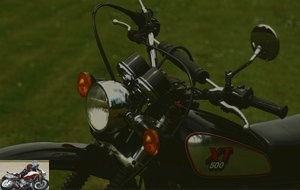
The gist is there and ultimately the Yamaha is not stingy when it comes to commodos and instrumentation. The red zone appears at 6500 rpm on the black-background tachometer, inviting more torque than power. There is the decompressor on the left hand which facilitates starting, like the window on the crankcase indicating the position of the piston in neutral. With a few procedures and regular ignition maintenance, kick-starting can go smoothly, although he has built up a solid reputation as a leg-breaker.!
Who kick ?
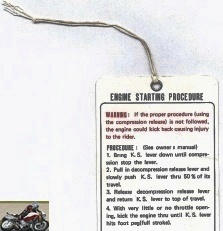 So the first time, it is not without emotion that we are about to start the machine. For the modern rider, a kicker is hardly natural. Like a pilot and his checklist, we repeat the procedure one last time. The more cowardly will be happy to learn that the purists start by hand…. Cold choke, gas closed, press the kickstarter until you feel the compression point (opaque window). We decompress on the handlebars while pressing the kickstarter halfway. By releasing the trigger, the kickstarter is allowed to rise (transparent window). It’s time to liven up the beast with an elegant, firm hock. Engine, we fully savor his victory over Kick, the comeback, reveling in the characteristic and lively sound of the exhaust.
So the first time, it is not without emotion that we are about to start the machine. For the modern rider, a kicker is hardly natural. Like a pilot and his checklist, we repeat the procedure one last time. The more cowardly will be happy to learn that the purists start by hand…. Cold choke, gas closed, press the kickstarter until you feel the compression point (opaque window). We decompress on the handlebars while pressing the kickstarter halfway. By releasing the trigger, the kickstarter is allowed to rise (transparent window). It’s time to liven up the beast with an elegant, firm hock. Engine, we fully savor his victory over Kick, the comeback, reveling in the characteristic and lively sound of the exhaust.
If the engine has only 32 horsepower, they are thoroughbreds. Not very powerful, yet it responds from the lowest revs, ready to pounce at the slightest request, enough to graze between two fires without blushing. In contrast, the "old fashion" architecture of mono requires playing with the selector and the clutch. It bangs down, lacks reach in the towers, and vibrates generously. Single cylinders have not been popular since the early 1990s, but they have become sanitized over time.
4-valve cylinder head, double camshaft and balancing arm…. By trying to smooth out the defects, we also castrate the intrinsic characteristics. If, as is often the case, imperfections make the character of a machine, does the weak braking of the 500 XT contribute to it? While the generalization of ABS on new motorcycles begins to be mentioned, it is clear that the front / rear drums of our mount, slow more than they brake. Anticipation strongly advised. Regarding duo rides, a good dose of friendship from the person transported is necessary. Lack of grab handles, dry suspensions, proximity thigh / uncomfortable exhaust … In addition, the added pounds affect the drive of the single cylinder. The saddle of the 500 XT is readily shared for a chip jump, but not much more…
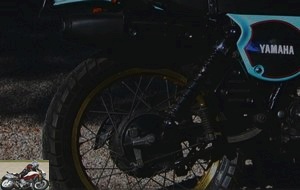
Back to basics
To escape the gloomy ambient road, the 500 XT is one of the most effective remedy, a simple recipe for biker happiness. Its engine is expressive and lively, playful without being inclined to crime and generates excellent sensations. It remains to adapt to vibrations and braking worthy of the gramophone in the age of MP3.
Accessible and mechanically reliable, its regular use does not incur an excessive budget. There are still plenty of parts and a wealth of information to be found among the many aficionados of the one who won the first Dakar. Capital that we must join on a 500 XT. It’s never too late to live your dreams !
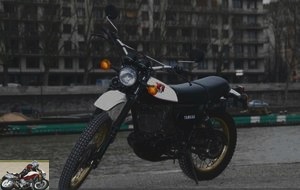
Chronology
- 1976 The first XT 500 type 1E6 version was replaced in July by the type 1N5 model, the main difference being in the exhaust (rear part of the muffler which loses its narrowing end).
- 1977 The XT evolves and takes the type 1U6. Certainly the most famous of the series, it is characterized by the presence of the small window on the engine which makes it possible to visualize the mark to position the piston correctly at start-up. The passage of the collector is modified for a lateral positioning which improves the ground clearance and exposes it less to the shocks.
- 1978 The cylinder head receives a larger wing, the chain case is replaced and the tees are modified with two bolts per tube.
- 1979 Modifications are made to the engine to improve reliability: fitting of the crankshaft oil seal on the right side with the lip positioned externally and its immobilization by a circlip, modification of the lubrication circuit and of the clutch housing. The "Enduro" inscription disappears from the side covers.
- 1980 The XT goes back through the homologation box because of a new definition of the geometry of the steering column and the resulting characteristics: shorter offset-axle fork, but unchanged travel, reduced column-to-fork tube center distance. The inlet valve comes from the SR 500 (+ 2mm). The tank changes to aluminum and the rims are coated with gold anodization.
- 1981-85 The characteristics of the XT stabilize and only the engine from number 1U6 163 396 receives modifications, such as the adoption of a screw and a latch to immobilize the rocker arms which tended to damage their housing.
- 1986 Important change with the switch of the electrical system to 12 volts.
- 1987-89 No technical change. In 1989, marketing of a limited "anniversary" series called XT500SP with various chrome or polished parts.
- 1990 The XT is withdrawn from the Yamaha France catalog and the last new XT500 is officially sold in 1992 by a dealer of the brand.
Second-hand market
Produced in 61,510 copies worldwide, including 17,884 copies for France. The market was teeming with machinery and parts in the late 1990s, but now nostalgia drives up market prices. For a little less than 1,000 €, there are machines to restore. Let’s not forget that the oldest are already over thirty years old. In other words, they have had several lives that have not always spared them. The market average is around 2,000 to 2,500 € with mileage between 30 and 50,000 km. Add a good thousand euros to it if you dream of a machine in fully restored competition condition.
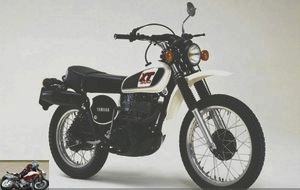
Identification
- 1976 – 1E6 – 1E6 001 101
- 1976 – 1N5 – 1N5 000 101
- 1977 – 1U6 – 1U6 000 101
- 1979 – 1U6 – 1U6 110 101
- 1980 – 1U6 – 1U6 130 101
- 1981 – 1U6 – 1U6 140 101
- 1986 – 1U6 – 1U6 205 101
- 1988 – 1U6 – 1U6 209 101
- 1989 – 1U6 – 1U6 212 101
Chassis: distrust
Some riders may have had a little too much fun off-roading. Others couldn’t resist playing pranks on the rear wheel. So make sure the frame is level and the wheels are aligned. Overloaded welds are a bad sign, check that the oil cooler in the frame is not cracked.
The life expectancy of bearings in the steering and swingarm rarely exceeds 20,000 km. Make sure there are no hard spots, especially on the swingarm, there may be a risk of welding with the impossibility of dismantling! Auscultate the rear suspensions which must not show any leaks or hard points and whose rods are straight.
Solid mechanics, but ….
The air filter with the muffler are the elements that hamper performance the most. Preparations based on filter horn and tampered with exhaust can impair reliability (burnt valves), causing excessive consumption of fuel and lubricant. Prefer a model whose segmentation was changed less than 25,000 km ago. The models equipped with an engine kit (600 cm3) prove to be more reliable than the original ones on the sealing side. The rocker arms are the weak point of the engine. Sometimes before 1984, the rocker covers have play and oil goes into the bearings instead of greasing the rocker arms and their shafts..
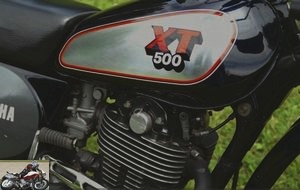
Maintenance
Overall a reliable machine at the cost of minimum maintenance. Gasoline consumption 5 liters per 100, normal oil consumption between ½ and 1 l of oil per 1000 km.
Gas station
Engine oil every 3,000 km with replacement of the filter. 15w50 oil. Check the air filter and the spark plug and valve clearance every 3,000 km. Lubrication of the swingarm pivot every 3,000 km. Adjustment of rocker arms and timing chain tension every 5,000 km or less. Every 10,000 km, cleaning of breakers for models before 1986. Replacing the timing chain every 40,000 km.

Detached pieces
There are still some original references from Yamaha. The popularity of XT via the Internet is in favor of enthusiasts. There are thus in Germany and Holland two specialized companies offering a large number of parts. Props have also looked into the XT’s case throughout its career, but stocks are starting to run out.
Finally, announcements, forums, trade fairs and flea markets also make it possible to find the desired piece. Apart from the switch to 12 volts in 1986 and the change of the clutch cover in 1979 (risk of engine failure), almost everything is compatible on the XT from one year to the next.
Strong points
- Living engine
- Maneuverability and lightness
- Proven reliability
- Mythical machine
Weak points
- Overpriced market
- Ineffective braking
- Symbolic lighting (on 6v)
- Fierce vibrations
The technical sheet of the trail 500 XT
Related articles
-
V2, 942 cm3, 54 hp, 81 Nm, 252 kilos, € 9,999 A scrambler made on the basis of the XV 950 customs Free your chains! Yes, refuse conformism, finally…
-
200 hp at 13,500 rpm, 112 N.m at 11,500 rpm, 199 kilos with full fuel, from € 18,499 Is the Crossplane engine an advantage in road use ? Even if the…
-
Aprilia RSV1000 model 2000 biker tests: Emmanuel Historical Aprilia manufactured until 1999 from 50 to 250cm3 with holes that stink . They triumph on the…
-
Single cylinder, 4-stroke, 124.4 cm3, 15 hp at 10,000 rpm, 11.5 Nm at 8,000 rpm, 134 kilos, € 4,599 A little sportswoman who worthily represents the…
-
At maturity If the Duke 3 was an exotic outsider against classic roadsters, this fourth generation largely deserves its place in the family and is a…
-
6 cylinders in line, 1649 cm3, 160 hp at 7,750 rpm, 175 Nm at 5,250 rpm, from € 23,250 The first GT you can buy before you’re old ! BMW has simply…
-
A power cruiser with Italian sauce. Punch, style, noise, character ! V2 1262 cm3, 152 hp at 9,500 rpm, 12.8 m / kg at 5,000 rpm, 220 kilos dry, from…
-
Harley-Davidson Forty-Eight and A2 test
1202 cm3, approx. 60 horsepower at 5500 rpm, 96 Nm at 3500 rpm, 252 kilos with full tank, from 12,410 € A minimalist and very stylish machine, generous…
-
Waiting for the new Hornet… No, the CB 650 F is not the replacement for the Hornet. Healthy, easy and fast enough, it is intended primarily for…
-
A new entrant noticed in the niche of fun and stylish roadsters Single cylinder, 692 cm3, 75 hp at 8,500 rpm, 72 Nm at 6,750 rpm, 157 kilos dry, € 10,290…